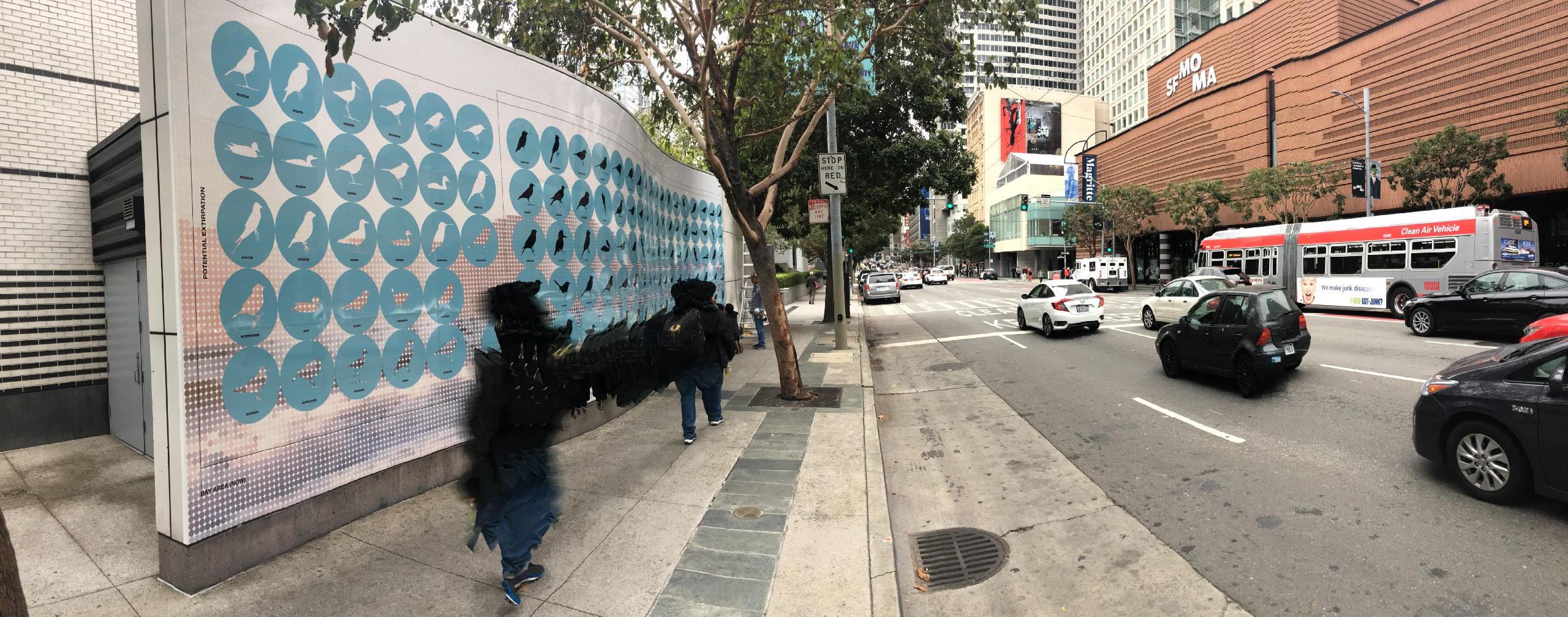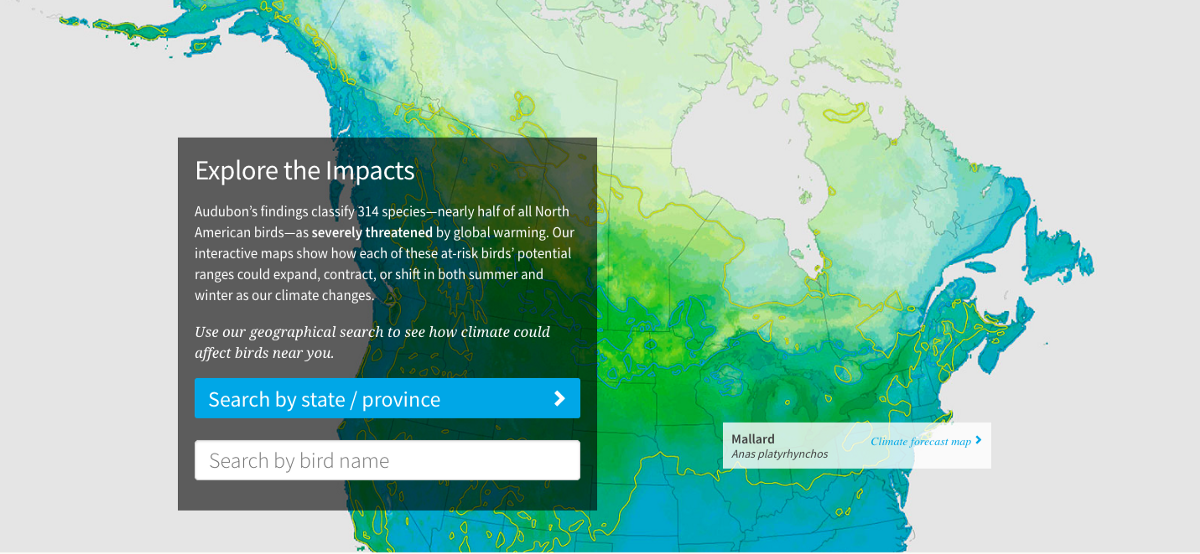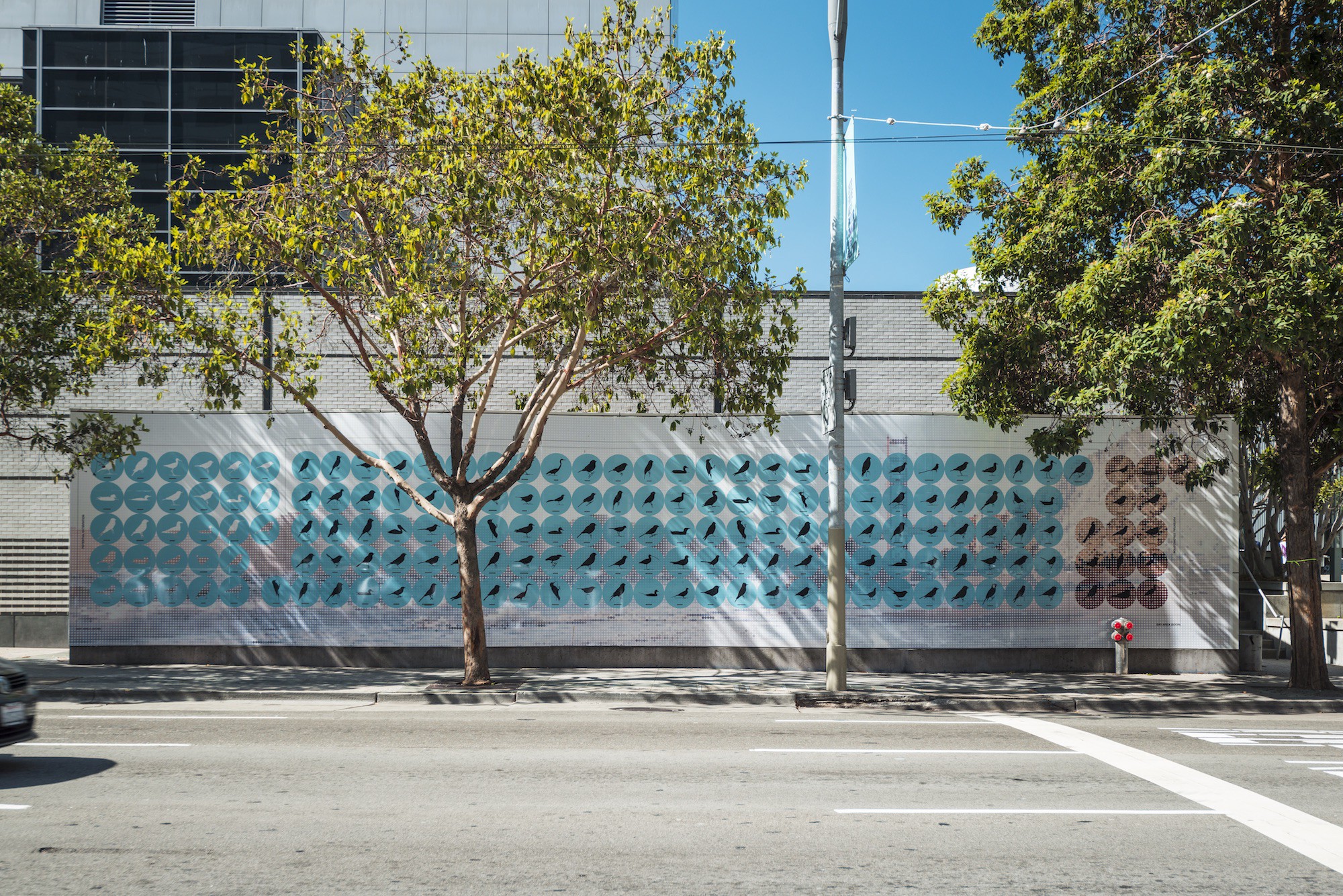
This conversation is about Stamen’s recent mural for YBCA’s Bay Area Now show. The mural, which is 60 feet long and at the corner of Mission and Third Streets in San Francisco, is about the impact that climate change will have on bird populations in the Golden Gate Recreational Area, just north of San Francisco, using data from the Audubon Birds & Climate Report.
Nicolette Hayes: Most of what we do here at Stamen is digitally-based and on small surfaces. We’re used to using techniques like animation and interaction to make them come to life. With a mural, the inverse is true, especially at this scale. It’s so big and you can only look at a certain part of the canvas at a time. So the problem became: how to make use of this giant canvas? Especially given that there were two different scales: one which was close up and the other far away.
Eric Rodenbeck: So this is about zooming with your face?
NH Exactly! Your first request was you wanted something that would have at least two zoom levels, right? It should tell an interesting story from up close. It should also tell a parallel complementary story from farther away. It’s not a billboard.
ER You’re trying to bring the benefits that you can get from interaction into a static panel? And you get to do that because it’s so big.
NH Exactly. We felt like we had an extra opportunity because it was so big.
In our original Audubon project (here, here), we looked at future climate suitability for 314 species across the U.S. and Canada. The second project, The Future of Birds In Our National Parks, took that same science and applied it at a higher resolution to the specific geographies of the National Parks System. We had one data set for each national park. Each page showed a single park, showing a few things. First, the birds that currently live in that environment. Second, the ones that will no longer be able to live in that environment given climate change. Third, the new ones that are likely to arrive. This is the modeling that Audubon scientists are doing around changes that the models predict in 50 years.
We’re trying to encourage a kind of thinking about climate change from a more holistic sense. We didn’t want to focus on the doom and gloom, we’re-all-going-to-die side of climate change. We had the opportunity to talk about it as a scientific reality. Specific landscapes will change in specific ways.
ER So it’s not about putting a positive spin on climate change by any means! It’s more about talking about it in a way that’s local and also connected to global trends. That’s a nice parallel to this idea of looking at the mural from far away and looking at it close up. There are different levels to telling the story and to making it concrete and tangible.
NH There are 169 birds on the mural. Audubon gave us data on birds in all the nation’s national parks. It was up to us to figure out what cross section we should use to make the mural local. The closest place to us was the Golden Gate National Recreation Area, a large natural area nearby. Audubon gave us two slices through the data, both summer and winter ranges. And then there was a large degree of variability in how many species lived in each place to begin with. I had my fingers crossed that even though it’s a very small park that we would have less than 100 birds to be working with.
ER There’s a tremendous diversity of birdlife in that park.
NH In the Bay Area, we’re very lucky that way. So of course, it wasn’t going to be one of those parks that had a small species count. We have all different kinds of habitats. And yeah, it’s a nice climate.
ER Looking at it now, most of the birds that live here now are still going to be able to live here in 50 years.
NH Yes. The large majority of them.
ER But some of them, some important ones, are not.
NH Such as the American robin, which is the one that made me saddest.
ER So no robins in the Bay Area?
NH Nope. No more robins.
ER Ouch. And it’s possible we’re going to start seeing some birds that we’ve never seen here before.
NH There’s this one pretty giant bird called an anhinga that I have never heard of that may be coming soon.
ER It’s terrifying to think about.
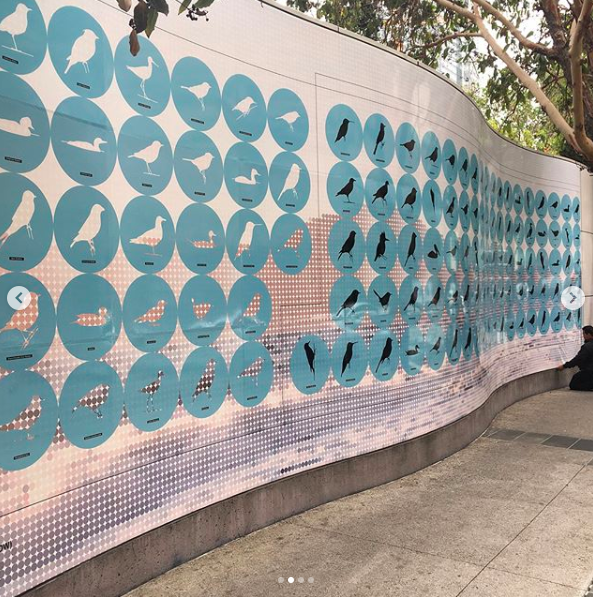
The scale of the mural is fun for me to contemplate. There are different opportunities available because of that scale.
NH The other thing is that the surface of the mural is wavy. It’s not a flat surface. If you’re standing at one end and looking down across it, if you’re one foot away, you’re not seeing the whole mural. You’re seeing the waves. You’re seeing the apex of each section of the mural as it juts out. That gives you a vertical cross section. Imagine vertical slices of something that you were going to be looking at. What information would you be able to see that would then be meaningful? So that’s partly why that last wave is the area where you see the birds that are coming soon. The first wave is where they’re going away. I don’t think I would’ve thought about it in that way if it wasn’t for the actual physicality of the wall.
ER This happens to me a lot as we design things. I’ll do some work, and only, in retrospect, understand what’s most interesting about it. Same here. You didn’t sit there and draw the waves. You designed the mural as a flat piece. You started to notice different things when you saw it installed by those master craftsmen.
And that’s what you want. Right? You want to make something that rewards repeat viewing. That’s something that I want from the work that we do. I don’t want it only to be beautiful to look at or fun. I want you to be able to come back to it a couple different times and find different things in it. You should notice things that you wouldn’t have noticed the first time you looked at it.
NH When you’re standing up close into the mural, you do have your own bit of protected space. If you only look at this as one giant canvas, you kind of don’t know where to start. But when you’re standing there, then it creates sort of a natural barrier to your frame of vision. So that you’re actually focusing on the things that are nearest to you and around you.
ER A 60-foot long mural that requires that you stand right next to it to read it is my kind of fun.
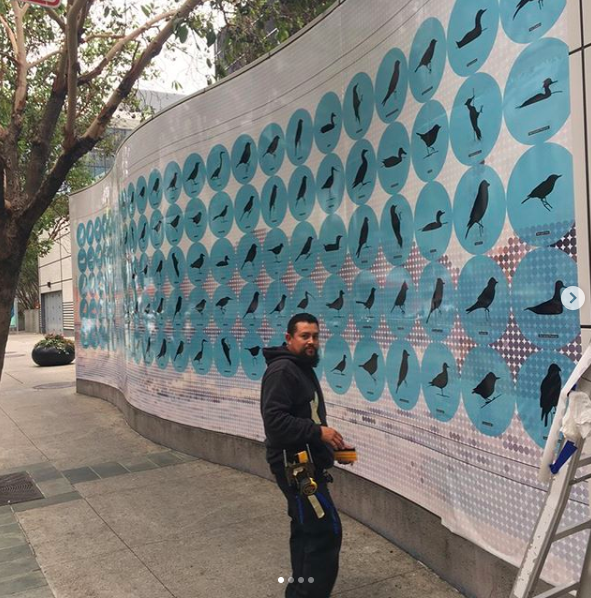
NH It took me a while to figure out the size the text labels needed to be. When you’re standing close to the type, you don’t need it to be that big. But then I realized that the topmost birds on the mural would be six feet above my head! I needed their labels to be readable from six feet away, even if I’m only two inches from the mural with my nose. So then I had to change everything a little bit.
ER It’s a strange location. It’s not like you can stand there and contemplate it since there’s so much foot traffic right there. It’s quite a busy space. It was especially busy during Climate Action Week, right after the installation.
NH There’s a physical constraint that I had to deal with that actually ended up being an addition to the design. I wasn’t going to be able to get my hands on any imagery that was high enough resolution to be able to use it at that scale. And that, in a very good designy way, was okay, because constraints make design interesting. It meant that I took an image of the Golden Gate Bridge and distilled it way down to halftone dots. They’re not technically halftone since they’re all the same size. The idea of distilling an entire landscape became its own metaphor for the mural. But the scale of this thing is about the entire world of birds and how that’s all going to change. So for me, that was what the foreground and the background ended up representing. There are these particular birds that we’re talking about, sure. But there are millions of birds that are the background for this conversation about climate change.
ER In some ways that’s the theme of the work, right? That climate change is too big to get your brain around. And one way to approach a topic this big is to focus on a of slice of it that people care about. I love that about what Audubon’s doing. They decided they were going to talk about this through the lens of birds. Birds are something that people pay attention to and that they go out of their way to try and find.
NH And they have expertise on. Yeah.
ER Can we talk about the process of making a mural that is not commissioned, that’s not a client project? YBCA commissioned us to do it, but they didn’t come to us with a specific idea. And the design process was a different kind of back and forth than you would have with a typical client. There’s a brief, something to respond to that’s specific. There’s a schedule and all that kind of thing for a project like this, sure. But there’s also a different review process, and a different kind of sketching process.
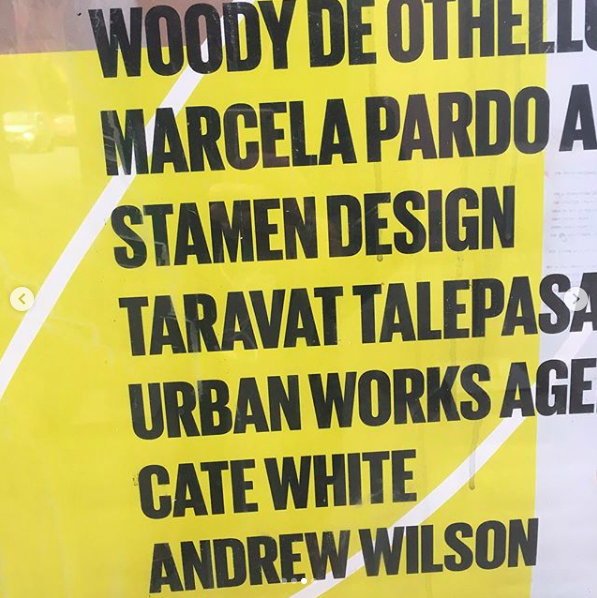
NH This was a riff on a project that we had worked on before with a client. One of my self-imposed constraints was to make the birds as accurate as possible. I know that bird identification for actual birders is often done using silhouettes. The profile of the bird is one of the things that you can use to identify it through your binoculars when they’re in the far distance or backlit. It’s important. Birders are serious, and faking it wasn’t going to be good enough. I definitely made this for the birders! Because I didn’t have anyone else to be making it for except for ourselves. I wanted it to be true to that data. And that data was that each one of these birds was an individual. We were distilling it because there are 169 birds. We’re putting circles around them, and we’re saying that this is data. You get to this very personal relationship with each individual bird, because you get to zoom in with your face. I wanted that bird to still be itself and not be some sort of artistic rendition of itself. I wanted it to be as literal as possible.
ER I’ve read critiques of data visualization projects. It’s said they reduce all the complexity of actual lived experience to a single data point. Fair enough. So what you’re doing is a way to bring some of that back. It’s not only 129 dots, it’s 129 individual bird silhouettes which you did by hand as I recall.
NH It was insane. I started drawing them and then a couple hours went by and I’d only done like 20. And I was like, “Wait a minute. How long does it take me to do each of these birds?” And it turns out it was 5–10 minutes, which times 169 was just way too long. And so I thought to myself, “I’ve got to go faster. I have to be faster at this.” So I put myself on to a two to three minute schedule for drawing the birds.
ER And you feel like you kept the right amount of accuracy?
NH I did. I think that they’re pretty good. Yeah. Anyone can challenge me on that.
You were saying about how dataviz distills the information down to be dots. That came up in a very specific way while working with Andrew Wong on the digital representation of this project. He was always looking for opportunities to tie the work back to the actual birds. He thought it was exciting that we were showing this data. But that it was only exciting inasmuch as you understood what it was you were looking at. I didn’t ask him what I should do for the mural but in my head, I knew that he was telling me what I should do on this mural. But that was really exciting to be feeling, “Oh, we finally get to do that thing Andrew and I talked about. We get to make the birds come to life.”
ER Let’s talk about the exhibition at Bay Area Now 8. This was the first BAN that included architects and designers. It’s typically been only art. I’d say that it represents what’s going on in this region that surrounds a bay. It’s very fragmented and disconnected in a lot of ways, even though it self-identifies as “the Bay Area.” There’s sort of the defining characteristic of it and some ways is its heterogeneity. And I imagine that’s also the case with the show. It included a huge variety of projects. We did our mural. Hyphae collected urine and processed the phosphate out of it. Caleb Duarte made a temporary installation out of dirt and walls and paintings. It was all over the place. This is the first Bay area now that I’ve known much about. To me, it doesn’t have much of a kind of identity other than it being about the Bay Area. But you had some thoughts about how well you thought what we came up with fit into the show. Not the theme of the show, but the nature of the show.
NH I felt that I tackled this from the beginning with the three words, “Bay Area Now.” I took that to mean whatever I wanted it to mean in terms of it’s the Bay Area and it’s “now.” And for me, in a lot of ways, that means nature. That means we can quantify the Bay Area as an actual place. “Now” is like this moment in time and the work that you’re doing now, and a snapshot of it. And so our mural is a very literal interpretation of that. It’s saying: what is a snapshot of the Bay Area right now? And coming right down to the name of it, which you came up with as Bay Area Soon. It was saying, we’re not only looking at Bay Area Now. But also what it could be in the near future.
From the Bay Area Now site: “The picture that emerges — of both the region and the artists who call it home — presents a resilient Bay Area, where humor and care come together with intimate reflections on individual and personal histories, and where bodies and geographies propose a fluid understanding of race, gender, and nature. Using materials as surrogates for gender and environmental politics, the participants point to an in-between space that, by rejecting rigid dichotomies, suggests a delicate optimism.”
ER This is good. “The participants point to an in-between space that by rejecting rigid dichotomies suggests a delicate optimism.” That’s just it.
NH Especially with climate change! Which is often so black and white feeling, and so big that you don’t even know what to do with it.
ER And that’s its challenge, right? Is that it’s black and white and it’s so big that you don’t know what to do with it. And so in some ways, the ability to even engage with that at all in a scenario that’s not either complete denial or utter doom and gloom is —
NH Yeah. Delicate optimism in the face of climate change.
ER It’s vital.
NH And hard to come by.
ER Okay. So we should talk about the video also. The mural was outside, not “in the show” at all. But we had a little bit of work on the inside, in the main show, that referenced the mural and the work of the web, right?
NH Yeah. Yeah. That was a funny thing for opening night. It was pretty easy to overlook the mural, because it was in a rather different space than where most of the party was. But ongoing, it’s a pretty cool opportunity. It’s both catching people on their way into YBCA, as well as people who wouldn’t be going to the exhibit at all. And maybe it could be a draw. Because the mural was outside, YBCA had us make these companion videos. They’d give insight into what the mural was in both a visual and conceptual sense. So we ended up with two screens in the show.
There’s one that’s a close-up view of a single transect. It simulates seeing up close the actual silhouettes of the birds with their names. And it’s pretty devoid of context. You don’t get to see whether you’re looking at the subset that is now, or soon, or whatever it is, you’re just really kind of immersed in the experience. So that’s what the video on the right was about. And the one on the left was more about capturing the story of how the mural came to be from a data sense. Starting with the data visualization work that we did for Audubon, so the map of the different regions with all of the different national parks, then showing the rate of colonization versus extirpation, and then focusing in on the Golden Gate National Recreation Area and seeing how it will change over time. And then zooming in even further to a single bird, and then kind of bringing it back out to that bird’s context in the rest of the United States.
ER The engagement with scale continues to be something that’s important, right? That it’s about all the birds, and it’s about one bird, and it’s about the whole country and the whole world, but it’s also about this one specific place. You might say that the Bay Area has some of that resonance as well. There are people here from all over the world, but we’re dealing with these very hyper-local issues around gender, environmentalism and equity. So I like that the mural kind of steps squarely into that. I like stepping squarely into difficult conversations, and seeing what we can make happen in that space.
NH I think you should just write that blog post, specifically about that issue.
ER What do you mean?
NH I don’t know. I mean you could post the conversation we’ve just had. But you could also take what you just said and just turn it into a whole dissertation. I feel like it’s what people need to hear about right now.
ER I think you’re right, but I think I’ll save all that for another post. To be continued!
